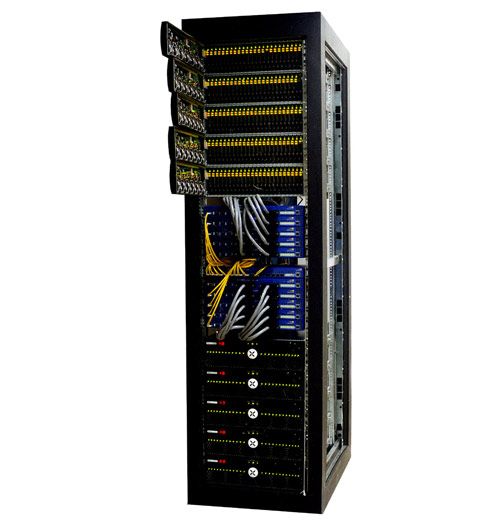Supercomputer Data Network Links Researchers at Blazing Download Speeds

The guys who first assembled the Internet are at it again, and this time, it's going to be a whole lot faster. The Department of Energy (DOE) will soon begin laying down 100 Gbps lines between its unclassified supercomputers. With connection speeds of 100Gbps, 1,000 times faster than modern broadband, this fiber optic network appears reminiscent of NSFNET, which linked supercomputers in the 1980s and later formed the backbone of the Internet.
Known as "the Advanced Networking Initiative" (ANI), the effort represents a $62 million multi-year investment by the DOE Office of Science in next-generation networking technology. The prototype network is a crucial bridge to a planned nationwide 100 Gbps scientific network that will support thousands of DOE scientists in their research on environmental modeling, developing energy solutions, and exploring the fundamental nature of the universe, as well as in accessing data from one-of-a-kind experimental facilities such as the Large Hadron Collider.
"As science becomes increasingly data-driven and global in scale, it's critical that we create an infrastructure that will enable our scientists to collaborate and compete successfully in the search for solutions to some of the world's biggest challenges in energy," said DOE Office of Science Director William F. Brinkman. "The Advanced Networking Initiative is the kind of investment that will help secure and maintain America's scientific pre-eminence and improve the quality of life for all of us."
The 100 Gbps prototype network, including hardware and dark fiber, will initially connect three DOE unclassified supercomputing centers: the National Energy Research Scientific Computing Center (NERSC) at Berkeley Lab, Oak Ridge Leadership Computing Facility (OLCF), and Argonne Leadership Computing Facility (ALCF), as well as the Manhattan Landing International Exchange Point (MANLAN). A portion of the funding also goes to the development of a national-scale network testbed, made available to researchers and industry for experiments with new network technologies, protocols and applications to help them get up to speed on the new 100 Gbps capability.
As part of the agreement, the Berkeley Lab has negotiated a 20-year lease on dark fiber capacity to be leveraged for so-called "disruptive" research, allowing DOE, industry and university researchers to use the facility to investigate new networking technologies and protocols, and effectively locking in the cost of future network infrastructure needs for the next two decades.
The ANI network will also jump-start ESnet's research in support of "green" energy-efficient networking – a hot priority as data volumes and network and supercomputing center energy demands keep rising. With Berkeley Lab's commitment to lead efforts in carbon reduction and energy efficiency for research, the ANI 100 Gbps prototype will be instrumental in providing measurements of network energy consumption on a real-time basis.
It may take a little while for the 100Gbps lines to reach the consumers. It took 20 years for the connections of NSFNET to become common place in the U.S., and many Americans still lack broadband connections in their homes. However, if the next generation is going to start anyone, it would be here, where the first generation also got its start.
Sign up for the Live Science daily newsletter now
Get the world’s most fascinating discoveries delivered straight to your inbox.
This story was provided by InnovationNewsDaily, a sister site to Live Science. Follow InnovationNewsDaily on Twitter @News_Innovation, or on Facebook.













